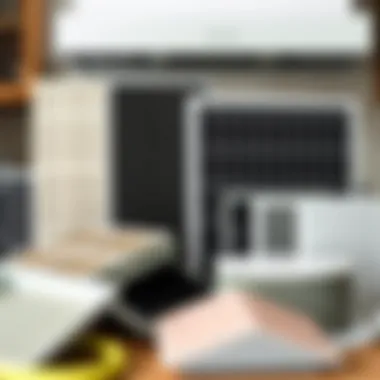Understanding Range Hood Carbon Filters for Clean Air


Intro
Range hood carbon filters serve a vital role in improving indoor air quality, especially in kitchens where cooking can release a plethora of odors, grease, and smoke. These filters catch unwanted particles and pollutants, helping to keep your living space fresh and pleasant. In the bustling world of home improvement and design, it’s not just about aesthetics; functionality matters too. If you're a homeowner, interior designer, or an enthusiastic DIYer, understanding the nuances of these filters is essential.
As we navigate through the intricacies of range hood carbon filters, this guide will break down their importance, types, installation methods, maintenance tips, and troubleshooting strategies. We’ll also look at how these filters vary in different cooking environments. By the end, you’ll be equipped to make informed decisions about your kitchen ventilation systems and ensure that your living space remains both stylish and functional.
The Role of Carbon Filters
Before getting into the nitty-gritty of installation and maintenance, it’s crucial to grasp what carbon filters do. While they can’t eliminate cooking byproducts entirely, they act as a barrier, capturing grease, odors, and other airborne particles.
- Odor Control: Carbon filters are adept at absorbing smells from cooked food, which can linger long after the cooking is done.
- Grease Filtration: They trap grease, preventing it from settling on your cabinets and countertops.
- Air Quality Improvement: Effectively maintaining good air quality is often overlooked, yet it’s essential for health, especially for those with allergies or respiratory issues.
In essence, these filters take on the heavy lifting, ensuring your kitchen remains a welcoming space.
Types of Range Hood Carbon Filters
When it comes to choosing a carbon filter, not all are made equal. Here’s a dive into various types that are commonly seen in households:
- Universal Carbon Filters: These are versatile filters that can fit a range of hoods and brands, making them a popular option for many.
- Specific Brand Filters: For those who prefer precise fit and compatibility, some brands manufacture filters strictly for their models. Examples include Broan and Whirlpool.
- Reusable Carbon Filters: Although they involve an upfront investment, these filters can be cleaned and reused multiple times, making them environmentally friendly.
The choice of your carbon filter plays a significant role in your kitchen's air purification efficiency. Be mindful of the compatibility with your range hood.
Installation Process
Installing a carbon filter may seem daunting, but it's a manageable task if you follow simple steps:
- Refer to the Manual: Each range hood model comes with specific instructions, so it’s highly recommended to consult the user manual.
- Turn Off Power: Always prioritize safety; disconnect the range hood from the power source before beginning.
- Remove the Old Filter: If you're replacing an old filter, take it out carefully to avoid damaging other components.
- Install the New Filter: Secure the new carbon filter in place, ensuring it fits snugly without any gaps.
- Test it Out: After installation, turn the power back on to check if it operates without issues.
Maintenance Tips
Regular maintenance of carbon filters is paramount for optimal performance. Here are some tips to keep them working their best:
- Clean Filters Regularly: Depending on your cooking frequency, cleaning every month is advisable. Most reusable filters can be washed in warm soapy water.
- Change Filters on Schedule: If using disposable filters, a typical change-out schedule is every 6-12 months. Keep an eye on the condition of your filters as they can clog over time.
- Visual Inspections: Check for any signs of wear or heavy grease buildup. A filter in poor condition might need changing sooner.
Understanding these aspects of range hood carbon filters will not only help in maintaining better air quality in your home but also extend the lifespan of your kitchen appliances. As we move through this guide, be prepared to dive deeper into troubleshooting methods and additional insights that can enhance your kitchen experience, ensuring that the heart of your home remains a breathing, healthy space.
Prelims to Range Hood Carbon Filters
When it comes to keeping our kitchens clean and breathable, the often-overlooked hero is the range hood carbon filter. While many might focus on cooking techniques or the latest kitchen gadgets, the importance of these filters can’t be brushed aside. They play a critical role in capturing smoke, grease, and odors, ensuring that the air we breathe remains fresh. Understanding this aspect is vital not only for homeowners looking to invest in their kitchen but also for interior designers and decorators wanting to create inviting spaces.
What are Range Hood Carbon Filters?
Range hood carbon filters are specially designed components used primarily in recirculating range hoods. Their main purpose? To capture and neutralize unwanted odors and smoke produced during cooking. These filters are made from activated carbon, a material known for its excellent adsorption properties.
Now, how does this work? Think of activated carbon as a sponge; it absorbs unwanted particles and gases in the air. When you’re frying up some onion rings or sautéing garlic, a lot of volatile organic compounds (VOCs) are generated. Without proper ventilation, these can hang in your kitchen, creating an uncomfortable environment. Carbon filters tackle this issue effectively, keeping your space looking and smelling clean.
The Role of Carbon Filters in Kitchen Ventilation
Kitchen ventilation encompasses various solutions — from exhaust fans to whole-house systems. Carbon filters fit into this equation by providing an additional layer of air purification. They don’t just remove smells; they also enhance overall air quality, making it easier to cook without feeling overwhelmed by odors.
Benefits of carbon filters include:
- Neutralization of Odors: They trap unpleasant cooking smells, preventing them from lingering.
- Reduction of Pollutants: By capturing airborne grease and other particulates, they contribute to better indoor air quality.
- Safety: Efficient filtration can minimize the risk of fire hazards caused by grease buildup in ductwork.
Consider this: cooking is essential, but so is sustaining air cleanliness. Without effective filtration, you might find yourself opening windows just to breathe, which isn’t ideal, especially in colder months.
In summary, understanding range hood carbon filters is crucial for maintaining a comfortable kitchen environment. They not only enhance your cooking experience but also protect your home from potential hazards. As we delve deeper into the types and installation processes of these filters, you’ll see just how intricate this subject can be.
Types of Carbon Filters
Understanding the different types of carbon filters is key in making an informed choice for your range hood. Each type comes with its own unique properties and benefits, catering to various needs and kitchen setups. Selecting the right filter not only ensures effective air purification but also contributes to a more pleasant cooking environment. Here, we delve into three primary varieties of carbon filters: Standard Activated Carbon Filters, High-Efficiency Activated Carbon Filters, and the comparison between Reusable and Disposable Filters.


Standard Activated Carbon Filters
Standard activated carbon filters are the bread and butter of kitchen ventilation systems. These inexpensive filters utilize activated carbon to capture odors and other airborne impurities that are typically produced while cooking. They often consist of a porous structure that allows them to trap the tiny particles found in the air, effectively neutralizing unpleasant smells. What makes these filters a popular choice among homeowners is their accessibility and ease of use. They fit well in most range hoods and have a decent lifespan, usually lasting around three to six months under normal cooking conditions.
However, it’s important to note that the effectiveness of standard activated carbon filters may diminish in high-demand cooking situations, where strong odors or high levels of grease are produced. While they can do a solid job for everyday meals, those who regularly prepare stronger dishes might find themselves needing to replace these filters more frequently to maintain optimal performance.
High-Efficiency Activated Carbon Filters
For those looking for a bit more bang for their buck, high-efficiency activated carbon filters take the spotlight. These filters incorporate a greater concentration of activated carbon, designed to absorb a wider spectrum of particulates and odors. The higher cost may seem daunting at first, but many users find that the investment is worth it. They are generally more durable, boasting a longer lifespan, which can go up to twelve months or more, depending on usage.
The advanced filtration structure offers superior performance, especially in kitchens that see heavy use or are known for producing strong-smelling dishes, such as curries or fried foods. If you're someone who loves to cook, opting for high-efficiency activated carbon filters can significantly enhance your indoor air quality and create a more inviting atmosphere.
Reusable vs. Disposable Filters
When it comes to carbon filters, choosing between reusable and disposable can often feel like a head-scratcher. Reusable filters are designed for longevity, allowing you to wash and recharge them several times before disposal. This can be a more economical option in the long run, particularly if you cook often and are conscientious about environmental impact. Regular cleaning, however, is essential; failure to do so can lead to reduced efficiency over time.
On the flip side, disposable filters offer convenience. There's no need to worry about cleaning or upkeep. Simply swap them out when they’re due for a change. They come ready to install, and you won’t have to deal with the mess. But, they do generate more waste, which could be a concern for environmentally-minded individuals.
Ultimately, your choice will reflect your cooking habits, maintenance preferences, and sustainability goals.
"Choosing the right carbon filter is about finding the balance between performance and convenience. Think about how often you cook and the typical dishes you prepare. It’s a simple way to end up with the optimal solution for your kitchen."
Understanding these types not only shapes your kitchen’s air quality but guides you in selecting the most appropriate filter that meets your culinary lifestyle and air purification needs.
Selection Criteria for Carbon Filters
When choosing the right carbon filter for your range hood, it's essential to consider various factors that directly affect performance and air quality. Understanding these criteria can help you make a wiser choice, ensuring a fresher kitchen environment. Here, we'll delve into some key points that guide the selection process.
Understanding Airflow Requirements
Airflow plays a pivotal role in the effectiveness of carbon filters. The amount of air that needs to be filtered greatly depends on your specific cooking habits and the size of your kitchen. For example, if you often cook elaborate meals that produce a lot of smoke and odors, you'll need a filter that can handle a higher airflow rate.
- Check the CFM (Cubic Feet per Minute) rating of your range hood. A higher CFM means the hood can move more air, which requires a compatible carbon filter to maintain optimal efficiency.
- For kitchens with standard cooking activities, a filter rated between 200-600 CFM might suffice. However, for avid cooks, filter options that exceed 600 CFM can provide better air purification.
Remember, a filter that can't manage your kitchen's airflow is about as useful as a chocolate teapot. It’s crucial to ensure that your filter matches the demands of your cooking space.
Considerations for Filter Size
Size matters when it comes to carbon filters. An improperly sized filter can lead to issues like poor air quality and inefficient operation. Therefore, here’s what you need to keep in mind:
- Measure Your Range Hood: Before making a purchase, it's vital to measure the dimensions of your range hood to determine the correct size of the filter it needs.
- Check Compatibility: Different brands and models may have specific carbon filter sizes; always refer to your range hood manual or manufacturer specifications to find the appropriate filter size.
- Avoid Gaps: Choosing a filter that fits snugly into the designated space will help avoid any gaps where cooking odors and smoke could escape or linger.
To give you a clear picture, imagine trying to fit a square peg in a round hole—it's never going to work effectively.
Evaluating Filter Lifespan
The lifespan of a carbon filter can vary significantly based on several factors, including filter type, usage frequency, and cooking style. This evaluation helps you understand when it's time for a change. Here’s what you should consider:
- Manufacturer Recommendations: Always start by checking how long the manufacturer suggests the filter should last, which typically ranges from 3 to 12 months.
- Visual Inspection: Regularly inspect your filter for signs of discoloration or deterioration. If the filter appears saturated or brittle, it’s probably time for a replacement, even if you haven’t reached the listed lifespan.
- Cooking Frequency: If you cook often or tend to fry foods at high temperatures, you might find yourself needing to replace your filter more frequently.
"A stitch in time saves nine" - paying attention to your carbon filter’s lifespan can prevent bigger issues down the line.
Choosing the right carbon filter for your range hood requires careful consideration of airflow, size, and lifespan. These aspects not only enhance the efficiency of the filter but significantly contribute to improving indoor air quality.
Installation Process of Range Hood Carbon Filters
Installing range hood carbon filters is more than a simple DIY project; it’s a crucial step towards ensuring better air quality in your kitchen. These filters play a significant role in trapping airborne grease, odors, and pollutants that come from cooking. A thorough installation means efficient operation, maximizing the filter’s ability to clean the air, thus enhancing your cooking environment and your home’s overall atmosphere. It also allows the range hood to function at its peak, reducing the likelihood of inefficient performance and increasing the durability of both the filter and the unit.
Required Tools and Materials
Before diving into the installation, gather the necessary tools and materials. The right setup can help streamline the process:
- Screwdriver (usually Phillips-head)
- Replacement Carbon Filter that is compatible with your range hood model
- Scissors (occasionally helpful for adjusting size)
- Measuring Tape
- Permanent Marker (for marking any adjustments)
- Cleaning Cloth


Having these tools at your fingertips will save you time and headaches, making the installation a smooth operation.
Step-by-Step Installation Guide
- Turn Off the Power: Safety first! Make sure the range hood is completely turned off to avoid any accidents.
- Remove the Existing Filter: If a filter is already in place, carefully slide it out. Clean the surrounding area using a damp cloth to remove grease and dirt.
- Prepare the New Filter: Check the new filter’s dimensions with your measuring tape. If adjustments are necessary (sometimes filters need a little trimming), use your scissors for a neat cut.
- Install the New Filter: Align the new filter with the slots provided in the range hood. Gently slide it into place, making sure it fits snugly. It’s crucial that the filter seals properly to avoid air bypass.
- Power it Up: Once installed, restore the power to your range hood. Test the functionality by turning on the fan and checking for any unusual noises, ensuring that everything is working as it should.
- Regular Maintenance Scheduling: Mark your calendar for the next replacement or maintenance check, helping maintain the air quality over time.
Common Mistakes to Avoid
Installing carbon filters can seem straightforward, but common pitfalls can lead to unnecessary frustration. Here’s what to watch out for:
- Not Checking Compatibility: Always verify that the filter matches your specific range hood model. A mismatched filter can render your system ineffective.
- Skipping the Cleaning Step: Neglecting to clean the area around the filter might affect airflow and decrease efficiency.
- Ignoring Power Safety: Never underestimate safety. Always ensure the power is off before starting any work to avoid electric shock.
- Installing Loosely: A poorly fitted filter can lead to air leaks, which defeats the purpose of having a carbon filter.
"Proper installation of your range hood carbon filter is key. When done right, it not only keeps your kitchen fresh but also extends the life of your hood."
Taking the time to follow these steps carefully will result in an effectively functioning range hood that improves your kitchen's atmosphere. Whether you're a homeowner, designer, or in the renovation business, understanding and executing proper installations will go a long way.
Maintenance of Carbon Filters
Maintaining carbon filters is a pivotal aspect of ensuring optimal performance in your range hood system. Neglecting this critical component can lead to a noticeable decline in air quality, along with increased odors lingering in your kitchen. The ability to regularly maintain these filters not only extends the life of the filters but also promotes a healthier cooking environment. Essentially, keeping carbon filters in tip-top shape means less hassle for you in the long run and creates a pleasant atmosphere in your home.
Regular Cleaning Practices
Cleaning your carbon filters should be a regular part of your kitchen maintenance routine. Though carbon filters are designed to absorb odors and impurities from cooking, they can only do so effectively when kept clean. Here are some practical steps you can take:
- Remove the Filter: Always ensure your range hood is switched off before you remove the carbon filter. Gently glide it out of its housing, taking care not to damage any components.
- Soak in Warm Soapy Water: Prepare a mixture of warm water and a mild detergent. Allow the filter to soak for about 30 minutes. This helps dislodge any grease buildup, which might affect the filter's ability to absorb odors.
- Rinse Thoroughly: After soaking, rinse the filter meticulously under running water. Avoid any abrasive scrubbing pads that might scratch the carbon material.
- Air Dry Completely: Ensure that the filter is completely dry before reinstallation. Trapping moisture can lead to mold or unpleasant odors.
Adhering to these cleaning practices every month, or more often if you cook frequently, can significantly enhance performance. The result is a nice, clean airflow when you're whipping up your favorite meals.
Regular maintenance of carbon filters ensures they work efficiently, removing unwanted odors from your kitchen air, making cooking a much more enjoyable experience.
When to Replace Filters
Even with meticulous care, carbon filters don't last indefinitely. Knowing when to replace them is critical to maintaining indoor air quality and ensuring the effectiveness of your range hood. Here are some signs to watch for:
- Unpleasant Odors Persist: If after thorough cleaning, you still notice persistent odors while cooking, it's a significant indicator that the filter's absorption capacity has diminished.
- Visual Signs of Wear: Black carbon particles may start to dislodge, indicating that the filter is losing its integrity. A filter that looks tired often operates tired.
- Changes in Airflow: A marked decrease in airflow through the range hood could suggest that the filter is clogged with accumulated grease and contaminants.
Most carbon filters have a lifespan of approximately six months to a year, depending on usage. Keep an eye on the specific manufacturer's guidelines, which will typically provide recommendations for replacement based on your cooking habits.
Monitoring these factors can lead to longer-lasting filters and ultimately, a fresher kitchen atmosphere. Don't wait until it’s too late—replace those filters when needed and keep your cooking space feeling perfect.
Troubleshooting Common Issues
Being equipped with the knowledge about troubleshooting common issues related to range hood carbon filters can make a significant difference in maintaining optimal kitchen air quality. Recognizing when something's off can save homeowners the headache of persistent odors or inefficient filtration. Plus, a well-functioning system can enhance the cooking experience, helping you enjoy the culinary endeavors without unnecessary distractions.
Identifying Loss of Efficiency
It's not uncommon for range hood carbon filters to lose their efficiency over time. If you find that smoke or food odors linger in the kitchen longer than usual, it might be an early sign that your filter is losing its punch. Symptoms like these can indicate that the filter has become saturated and is no longer absorbing particulates effectively.
- Check the Performance: Run a simple test by turning on your range hood and monitoring air flow. If the suction feels weak—much like a tired vacuum—it’s time to investigate.
- Timing is Key: Consider how long it has been since your last filter change. Most carbon filters are not designed to last forever; usually, changing them every 3 to 6 months is a good rule of thumb, but it varies based on usage.
Identifying this loss of efficiency early can save you from the consequences of cooking in a space filled with unpleasant smells and air you don't want to breathe.
Addressing Unpleasant Odors
One of the most frustrating experiences in cooking is dealing with persistent odors. No one wants their home to smell like last week’s fish fry or burnt broccoli. If you find your range hood carbon filter isn’t mitigating these smells effectively, it’s time for some assessment.
- Inspect the Filter: A quick visual check can reveal if the filter is dirty or discernibly stained. A communal smell test can also be useful—if it smells worse when the fan is on, there might be an issue.
- Clean the Hoods: Sometimes, bad odors could stem from grease accumulating in the hood itself. Regular cleaning of both the filter and the hood is essential to maintain a fresh scent in your kitchen.
- Seal of Approval: If you are still encountering issues despite having a clean filter, double-check that there are no leaks or gaps in the hood. Even a small crack can let unwanted odors seep back into the air.
Resolving Noise Issues
A noisy range hood can be more than just a nuisance; it can be a signal that something isn't quite right. If your unit has started to sound like an airplane taking off, it's worth investigating.


- Listen Closely: Different types of noises can indicate distinct issues. A rattling sound might suggest loose screws or parts, while an unusual hum could hint at an electrical or motor problem.
- Check for Obstructions: Sometimes, the simplest solutions are the most overlooked. Dust or grease build-up can cause the fan to struggle, leading to unwanted noises. A thorough cleaning may be all that's needed.
- Consult the Manual: If you’ve ruled out the common culprits and the racket persists, take a peek at your user manual for troubleshooting guidance or contact customer support for specialized help.
Troubleshooting common issues with your range hood carbon filters is essential not just for maintaining air quality but also for ensuring a pleasant cooking environment.
By getting ahead of these problems, you can maintain the efficiency and longevity of your range hood, keeping your kitchen fresh and inviting. Knowing what to look for makes a crucial difference.
Environmental Considerations
When it comes to choosing carbon filters for your range hood, the environmental considerations can’t be brushed aside. The importance of this aspect ties directly into how these devices influence both indoor air quality and sustainability practices. More than just a home accessory, these filters can play a pivotal role in fostering a healthier living environment.
Impact of Carbon Filters on Indoor Air Quality
Carbon filters serve a vital function in purifying the air in cooking spaces. They trap and neutralize pollutants, odors, and harmful particles that can circulate in the kitchen during meal preparations. The filtration process mitigates indoor air contamination, which is especially significant in homes where cooking occurs regularly.
- Removes Unpleasant Odors: One of the primary benefits is the reduction or complete elimination of cooking odors. Think of those moments when you fry fish or sauté garlic; the lingering smell can be quite overpowering. A good carbon filter will absorb these odors effectively, ensuring that your home remains welcoming.
- Traps Harmful Particles: Carbon filters are designed to capture microscopic particles that might lead to respiratory issues over time. It’s noted that many carbon filters can absorb harmful gases like carbon monoxide, which emerges from certain cooking methods. Given that indoor air can be several times more polluted than outdoor air, this filtration becomes crucial.
"Indoor air quality plays a huge role in our overall health, with poor ventilation often leading to symptoms like headaches and fatigue."
- Healthier Environment: Regular use of effective carbon filters contributes positively to a healthier living atmosphere. For families or individuals with asthma or allergies, maintaining good air quality is not just a preference but a necessity.
Sustainability of Carbon Filters
Sustainability is another critical angle when evaluating carbon filters. The environmental footprint of a product matters, and understanding how carbon filters align with sustainable practices can help shape your decision.
- Material Sourcing: Many manufacturers are now turning to eco-friendly methods and materials in the production of carbon filters. Products that utilize renewable resources or recycled materials minimize environmental impact. It’s worth investigating brands that prioritize sustainable sourcing in their production processes.
- Life Cycle of Filters: The longevity of carbon filters is also essential. While many filters are disposable, some are designed to be reusable. This means that homeowners can minimize waste by simply washing and reusing certain types of filters, which in turn lowers the number of products that end up in landfills.
- End-of-Life Disposal: An effective carbon filter will also consider how it is disposed of after its lifespan. Many brands are investing in biodegradable options, ensuring that once a filter has served its purpose, it won’t add to pollution or remain in landfills for decades.
In summary, the role of carbon filters transcends mere kitchen utility; it taps into deeper environmental concerns that resonate with many homeowners today. When selecting a carbon filter, consider both its direct benefits to indoor air quality and its broader implications for sustainability.
Future Innovations in Carbon Filter Technology
The landscape of carbon filter technology is not static; it is evolving with the demands of modern kitchens. Future innovations hold the potential to significantly enhance the effectiveness of range hood carbon filters while also making them more user-friendly. This section focuses on the multiple facets of innovation in carbon filter technology, emphasizing how these advancements can benefit homeowners, interior designers, and DIY enthusiasts alike.
Advances in Filter Materials
The materials used in carbon filters have changed over the years, but the best is yet to come. Recent developments include the introduction of advanced composites that improve filtering performance. For instance, newer filters often include expanded graphite or activated carbon cloth, which can increase surface area and adsorption capacity. This means a quicker and more efficient removal of odors and pollutants from the air.
There’s also the exploration of bio-based materials that are both sustainable and effective. Filters made from renewable resources not only perform well but also appeal to the environmentally conscious consumer. With the rise of eco-friendly home products, integrating biodegradable materials into carbon filters is becoming ever more relevant.
Moreover, manufacturers are working to create filters that can capture a broader range of pollutants, adapting to various cooking methods and devices. This kind of versatility is crucial for people who often switch recipes or try different cuisines, since the types of grease and odors produced can vary widely.
Integration with Smart Home Systems
In our high-tech era, one cannot overlook the fusion of smart home technology with carbon filter systems. Integration with smart home ecosystems promises convenience and efficiency. Imagine being able to monitor and control your range hood’s carbon filter through your smartphone or tablet. You could easily check filter status, receive alerts when it's time for a cleaning or replacement, and even adjust ventilation levels based on real-time cooking conditions.
Smart sensors can track airflow and filter saturation, ensuring that the air quality remains at an optimal level. All of this contributes to a healthier indoor environment, and for anyone keen on energy conservation, being able to manage ventilation more precisely can help cut down on unnecessary energy expenditure.
Furthermore, voice-activated technology allows for hands-free operation, which is especially beneficial when multitasking in the kitchen. Just a simple command can activate or adjust your range hood, keeping the air fresh without the hassle of moving away from your cooking.
The future of carbon filter technology is not just about efficiency; it’s about making the kitchen experience more intuitive and connected.
Epilogue
In wrapping up our discussion about range hood carbon filters, it's essential to recognize their significant role in ensuring a healthier kitchen environment. Air quality is a major player in our well-being, and these filters are not just optional add-ons; they are a requisite for many households. Whether you're a home cook, a professional chef, or simply someone who enjoys gathering around the stove with family and friends, what you breathe in the kitchen matters.
A filter's primary job is to capture airborne particles and odors that arise from cooking. Without proper filtration, your kitchen can quickly become a haven for unwanted smells and pollutants. Effective range hood carbon filters serve more than just function; they embody a commitment to maintaining a clean and pleasant cooking space.
Summary of Key Points
- Understanding Types: Familiarizing oneself with the various types of carbon filters available—like standard activated and high-efficiency activated—enables a smarter selection process. Each has its unique strengths and recommended uses.
- Installation Importance: Proper installation can't be overlooked, as it significantly impacts performance. Knowing common pitfalls in the setup phase helps avoid future headaches.
- Regular Maintenance: Continuous upkeep ensures that filters operate at peak efficiency, extending their effective lifespan. It’s vital to know when to clean or replace them, to avoid any lapse in air quality.
- Environmental Responsibility: The choice of filter affects not only indoor air quality but can also have implications on broader environmental health. Opting for reusable options can contribute to sustainability.
Final Thoughts on Choosing Carbon Filters
Selecting the right carbon filter boils down to your specific needs and cooking habits, along with factors like filter size, airflow, and maintenance commitment. Before making a purchase, consider asking yourself the following:
- How often do you cook, and what types of food do you prepare?
- Are you looking for high efficiency, or is cost the primary concern?
- What is the environmental impact of your choice?
In the end, the goal is to make a choice that aligns with your lifestyle while promoting a clean and healthy kitchen atmosphere. Cooking should invoke joy rather than the fear of lingering odors or poor air quality. By understanding the nuances of range hood carbon filters, you empower yourself to create an enjoyable cooking experience for years to come.
"The kitchen is the heart of the home. Breathe easy in it."















